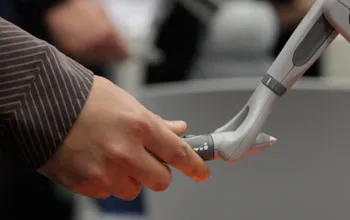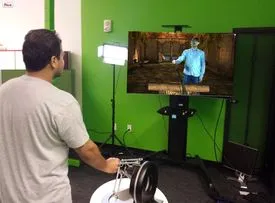Texas Vets 1st to Test New Cyber Rehab Technology

Starting in November, 25 Dallas-area veterans will be the first to try cutting-edge rehabilitation technology designed to transmit sensations of physical touch over the Internet, according to researchers at the University of Texas at Dallas who are leading the initial six-month trials.
The project, dubbed the Multi-modal 3D Tele-immersion Research Project, seeks to provide enhanced access to physical therapy for disabled veterans who cannot commute to the doctor’s office by combining recent advances in 3-D cameras, high-speed Internet connections, video game engines and the rapidly evolving field of “haptic,” or sense-of-touch, technology.
“We’re bringing the sense of touch to telemedicine,” said Dr. Balakrishnan Prabhakaran, computer science professor at UT-Dallas and the project’s principal investigator.

To continue reading please follow this link to Andy East’s Article on Austin American Statesman.com
UPDATE – 10/15/15
National Science Foundation (NSF) Discovery Article – Veterans will be First to try Cyber Physical Therapy
High-speed research networks help scientists develop and deploy future health technologies
The Internet has been transformational, changing how we communicate with friends and family, how we shop, and more recently, how we heal. Physical therapy is the latest treatment to be offered as telemedicine, with an experimental system now connecting specialists to patients to provide help they otherwise couldn’t get, aiding recovery from serious ailments, from broken limbs to stroke.
In an effort to connect physical therapy with wounded veterans far from treatment facilities, researchers from the University of Texas (UT) at Dallas have developed a rehabilitation system that uses real-time video, 3-D computer-generated worlds and force-feedback “haptic” devices to re-create a physical therapy session between a patient and a therapist, all at long distance over high-speed networks.
The team demonstrated the system at the Beyond Today’s Internet Summit in March 2015. Organized by US Ignite and the Global Environment for Networking Innovations (GENI), two groups dedicated to advancing the frontiers of the Internet, the event showed what new capabilities are possible with ultra-high-speed, “smart”, programmable networks.
Powerful Internet brings powerful applications
Though the majority of U.S. citizens still have Internet connection speeds in the tens of megabits per second, through the GENI and US Ignite programs, supported by the U.S. National Science Foundation, researchers, experts and some communities are able to access gigabit networks with speeds 40-100 times faster than standard networks.
For 3-D tele-rehabilitation to be lifelike and effective requires the system to have virtually no lag-time–or latency, in networking lingo–between action and reaction.
To continue reading Aaron Dubrow’s NSF article on Dr. Prabhakaran’s research on 3D Tele-Rehabilitation system Click here. To view the video “3-D tele-rehabilitation: Beyond Today’s Internet” click here.
ABOUT THE UT DALLAS COMPUTER SCIENCE DEPARTMENT
The UT Dallas Computer Science program is one of the largest Computer Science departments in the United States with over 1,600 bachelor’s-degree students, more than 1,100 master’s students, 160 PhD students, and 80 faculty members, as of Fall 2015. With The University of Texas at Dallas’ unique history of starting as a graduate institution first, the CS Department is built on a legacy of valuing innovative research and providing advanced training for software engineers and computer scientists.




